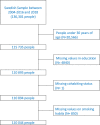Understanding the complexity of socioeconomic disparities in smoking prevalence in Sweden: a cross-sectional study applying intersectionality theory
- PMID: 33574148
- PMCID: PMC7880088
- DOI: 10.1136/bmjopen-2020-042323
Understanding the complexity of socioeconomic disparities in smoking prevalence in Sweden: a cross-sectional study applying intersectionality theory
Abstract
Objectives: Socioeconomic disparities in smoking prevalence remain a challenge to public health. The objective of this study was to present a simple methodology that displays intersectional patterns of smoking and quantify heterogeneities within groups to avoid inappropriate and potentially stigmatising conclusions exclusively based on group averages.
Setting: This is a cross-sectional observational study based on data from the National Health Surveys for Sweden (2004-2016 and 2018) including 136 301 individuals. We excluded people under 30 years of age, or missing information on education, household composition or smoking habits. The final sample consisted on 110 044 individuals or 80.7% of the original sample.
Outcome: Applying intersectional analysis of individual heterogeneity and discriminatory accuracy (AIHDA), we investigated the risk of self-reported smoking across 72 intersectional strata defined by age, gender, educational achievement, migration status and household composition.
Results: The distribution of smoking habit risk in the population was very heterogeneous. For instance, immigrant men aged 30-44 with low educational achievement that lived alone had a prevalence of smoking of 54% (95% CI 44% to 64%), around nine times higher than native women aged 65-84 with high educational achievement and living with other(s) that had a prevalence of 6% (95% CI 5% to 7%). The discriminatory accuracy of the information was moderate.
Conclusion: A more detailed, intersectional mapping of the socioeconomic and demographic disparities of smoking can assist in public health management aiming to eliminate this unhealthy habit from the community. Intersectionality theory together with AIHDA provides information that can guide resource allocation according to the concept proportionate universalism.
Keywords: epidemiology; health policy; public health; social medicine; statistics & research methods; substance misuse.
© Author(s) (or their employer(s)) 2021. Re-use permitted under CC BY. Published by BMJ.
Conflict of interest statement
Competing interests: None declared.
Figures
Similar articles
-
An intersectional analysis providing more precise information on inequities in self-rated health.Int J Equity Health. 2021 Feb 3;20(1):54. doi: 10.1186/s12939-020-01368-0. Int J Equity Health. 2021. PMID: 33536038 Free PMC article.
-
Revisiting socio-economic inequalities in sedentary leisure time in Sweden: An intersectional analysis of individual heterogeneity and discriminatory accuracy (AIHDA).Scand J Public Health. 2023 Jun;51(4):570-578. doi: 10.1177/14034948221112465. Epub 2022 Jul 26. Scand J Public Health. 2023. PMID: 35891588 Free PMC article.
-
Understanding the complexity of socioeconomic disparities in type 2 diabetes risk: a study of 4.3 million people in Sweden.BMJ Open Diabetes Res Care. 2019 Nov 7;7(1):e000749. doi: 10.1136/bmjdrc-2019-000749. eCollection 2019. BMJ Open Diabetes Res Care. 2019. PMID: 31798898 Free PMC article.
-
Perceived discrimination and refraining from seeking physician's care in Sweden: an intersectional analysis of individual heterogeneity and discriminatory accuracy (AIHDA).Int J Equity Health. 2024 Oct 5;23(1):199. doi: 10.1186/s12939-024-02291-4. Int J Equity Health. 2024. PMID: 39367379 Free PMC article.
-
Practice of reporting social characteristics when describing representativeness of epidemiological cohort studies - A rationale for an intersectional perspective.SSM Popul Health. 2020 Jun 20;11:100617. doi: 10.1016/j.ssmph.2020.100617. eCollection 2020 Aug. SSM Popul Health. 2020. PMID: 32685654 Free PMC article. Review.
Cited by
-
Social inequalities in the risk of giving birth to a small for gestational age child in Sweden 2010-16: a cross-sectional study adopting an intersectional approach.Eur J Public Health. 2024 Feb 5;34(1):22-28. doi: 10.1093/eurpub/ckad184. Eur J Public Health. 2024. PMID: 37878824 Free PMC article.
-
Disparities in overall and site-specific cancer mortality among immigrant generations in Sweden: a nationwide follow-up study over 3 decades.Am J Epidemiol. 2025 Aug 5;194(8):2325-2335. doi: 10.1093/aje/kwae388. Am J Epidemiol. 2025. PMID: 39367707 Free PMC article.
-
Geographical and sociodemographic differences in statin dispensation after acute myocardial infarction in Sweden: a register-based prospective cohort study applying analysis of individual heterogeneity and discriminatory accuracy (AIHDA) for basic comparisons of healthcare quality.BMJ Open. 2023 Sep 28;13(9):e063117. doi: 10.1136/bmjopen-2022-063117. BMJ Open. 2023. PMID: 37770265 Free PMC article.
-
Identifying intersectional groups at risk for missing breast cancer screening: Comparing regression- and decision tree-based approaches.SSM Popul Health. 2024 Dec 9;29:101736. doi: 10.1016/j.ssmph.2024.101736. eCollection 2025 Mar. SSM Popul Health. 2024. PMID: 39759381 Free PMC article.
-
Recommendations to advance equity in tobacco control.Tob Control. 2024 Nov 10;33(e2):e246-e253. doi: 10.1136/tc-2022-057670. Tob Control. 2024. PMID: 36535756
References
-
- Eek F, Ostergren P-O, Diderichsen F, et al. . Differences in socioeconomic and gender inequalities in tobacco smoking in Denmark and Sweden; a cross sectional comparison of the equity effect of different public health policies. BMC Public Health 2010;10:9. 10.1186/1471-2458-10-9 - DOI - PMC - PubMed
Publication types
MeSH terms
LinkOut - more resources
Full Text Sources
Other Literature Sources


